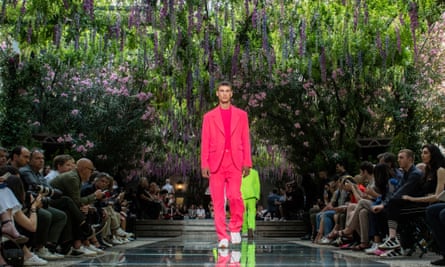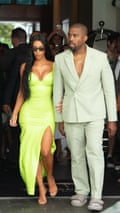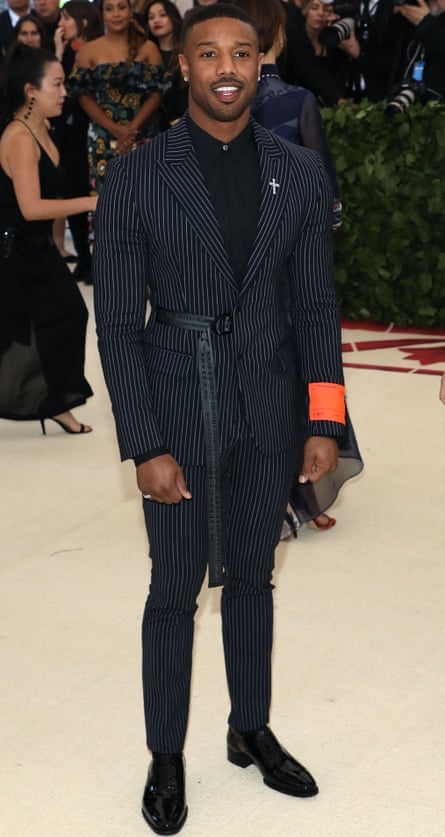The streetwear brand Supreme shocked the fashion world last year. No, it wasn’t the red-and-white logo-covered pinball machine, inflatable kayak or even the branded breathalyser it was selling. It was something so innocuous, so unexpected yet quotidian, the virtual opposite of a “shock tactic” in fact. Tucked away among all the hoodies, track pants and baseball caps typical of the much-hyped label, there was – wait for it – a classic two-piece suit. The item more readily associated with commuters and politicians than hoodie-wearing hype beasts had entered new territory.
It sent ripples through the streetwear community. GQ called it the Supreme piece they would most like to buy and, in an unlikely turn of events, suddenly trainer-hungry superfans were salivating over a blazer.
This isn’t just a standard suit, you see – it represents a shift in fashion, which has been dominated by streetwear for the last decade. Items such as hoodies, tracksuits and sneakers now populate menswear runways as a matter of course, and are sold for three figures by luxury retailers. According to the consulting firm Bain & Company, streetwear – once a niche sector – was forecast as one of four driving factors for an estimated 6-8% growth of the luxury market in 2018. Meanwhile, Supreme has gone from cult to serious fashion player. In October 2017, private equity firm the Carlyle Group bought a stake in the company. With the look moving from underground to mainstream, though, a streetwear saturation point has been reached. Enter the suit.

This season there were four major menswear designer debuts at luxury labels and all rallied behind the two-piece. At Kim Jones’s first outing at Dior, he gave the suit his blessing, with lightweight double-breasted ones in pastel pink and Big Bird yellow. Virgil Abloh, in a much-anticipated collection for Louis Vuitton, steered away from what might have been expected when looking at his streetwear-infused label Off-White, and instead opted for roomy tailoring in white, mint and candy-apple red. Riccardo Tisci, a pioneer of gothic-chic streetwear during his reign at Givenchy, showed tasteful, meeting room-friendly suits as part of his first Burberry collection. Meanwhile Hedi Slimane, showing menswear for the first time at Celine, presented his signature razor-sharp skinny suits in black.
The suit is obviously nothing new. It has been with us, in one form or another, for centuries – from French aristocrats’ matching redingotes and breeches in the early 1700s to England’s more conservative version popularised by Beau Brummell in the early 1800s and the preppy postwar American iteration championed by Brooks Brothers. Its longevity can be put down to its chameleon-like qualities. The suit has been spun in many different directions over the years, from the traditional (Gianni Agnelli, JFK Jr) to the foppish (Bryan Ferry, Wes Anderson) to the outright eccentric (David Bowie, André 3000). Then, of course, there are the myriad varieties seen in offices every day.

Interestingly, though, as its fashionability grows, the suit’s place in the corporate landscape is fading. Silicon Valley startup culture has ushered in a new age of casual dressing that makes off-duty clothes appropriate for the corner office. Two years ago, JPMorgan Chase announced that “business casual” was its new official everyday dress code. Last year, the business publication Inc. released a guide for companies to attract millennials with a more relaxed approach to workplace attire. With white-collar workers increasingly casual, the stuffy totem of adulthood and nine-to-five dressing that is the suit can be reassessed by a new generation of men who associate hoodies and trainers with the uniform of establishment figures such as Mark Zuckerberg or Evan Spiegel.
Andrew Cedotal, a 32-year-old Silicon Valley game designer, is an interesting case. He wears a suit or mixed suit separates, despite his notoriously casual environs – and likes what it semaphores. “Wearing a put-together outfit is a way of very easily communicating that you know how to build an organised and visually appealing presentation,” he says. “It’s a sign to people who are marketing experts that you know how to tell a story in a single glance.”
Cedotal is an outlier in the Bay Area, and can remember seeing only two other suit-wearers in the wilds of San Francisco. At companies he’s worked for, it’s mostly relegated to the legal team. In the tech industry, where “disruption” is a cherished value, he is in fact the rebellious one for wearing a throwback uniform. “I’ve had multiple people say that to me,” he laughs.

“Suiting suddenly feels subversive [in fashion],” says Brian Trunzo, senior menswear editor at WGSN, the global trend forecasting agency. “A traditional suit makes you do a double-take.” With social media feeds filled with streetwear, tailoring is unexpectedly fresh – and already enjoying the endorsement of fashion editors at the menswear shows, if street-style photography is anything to go by. Trunzo points to the range of new suiting options – from craft details at Calvin Klein and Dior to younger brands such as A-Cold-Wall* and Alyx marrying suiting with a streetwear sensibility – as ways in which the category is seeking a new audience. “I own 40-odd jackets and I haven’t worn one in years,” Trunzo says. “And the other day I found myself in a Rowing Blazers jacket and Nike Pigalle sweatpants, and I was like, ‘Whoa, what is happening? I’m falling victim to the resurgence of suiting.’”
Retailers are starting to see a spike in tailoring, too. Fiona Firth, buying director at Mr Porter, says, “In an age in which streetwear has ruled the runway, traditional tailoring has definitely fallen by the wayside as men dress more casually.” Over the last two seasons, however, the online luxury retailer has seen increased sales in the suiting category, up 30% last winter and set to grow this season. “It’s exciting to see how many luxury houses are introducing tailoring again, but making it relevant for young, casualwear-focused men,” Firth says.
Michael Adebayo, a 32-year-old GP based in the north-east of England, is someone for whom wearing a suit is optional – but he often does it anyway, he says, “in a more relaxed manner, without a tie or pocket square. These days, seeing people combining a suit with trainers or even shorts is amazing.” Adebayo uses suits to stand out – “Velvet and natural wool fabrics are my favourites” – rather than blend into a crowd. “I feel I can take on any challenge when wearing a suit and, most importantly, it makes people listen.”

No wonder suits are proving popular far beyond corporate environments, then. In October and November last year, there was a 33% year-on-year increase for the term “men’s suits” on the global fashion search platform Lyst. “It’s hit the radar of the consumer,” says Marshal Cohen, an analyst at market research firm NPD Group. “Suit separates seem to be the place it’s going to start. We’re already seeing it in the numbers.”
This new era of suiting won’t simply be a return to the slim-fitted “suited-and-booted” movement of the early noughties when Slimane’s skinny tailoring for Dior Homme dominated, but will bring the swagger of streetwear into the more traditional world of tailoring. Look at the mint green, oversized Louis Vuitton double-breasted suit Kanye West wore (with no shirt and slide sandals) over the summer, or Michael B Jordan’s Off-White suit with a belted waist and bright orange armband. Then there’s the floral appliquéd Haider Ackermann suit – a mix of rock’n’roll and romance – that Timothée Chalamet wore at the Toronto film festival in September, or DJ Benji B, more usually found in a bomber jacket or hoodie, in a Virgil Abloh-designed, loose-fitting Louis Vuitton suit at the Fashion Awards in December. Footwear is key – see Stormzy, a tracksuit devotee, on the front of Elle’s February issue in tailoring and trainers – a surefire way to de-corporate any suit.

Of course, for some, the suit never went out of style in the first place. Finance manager David D’Costa, 31, wears one as his “work uniform”. “A mentor in my first job guided me through the basics of suit wearing and over time I’ve developed my own style,” he says. Despite the suit’s formerly fusty reputation, he says seeing hordes of suit-wearers crossing London Bridge in the morning rush hour can be “a thing of beauty” and is in favour of more creative suit trends making their way into the boardroom.
Thomas Henry, a 34-year-old strategy director at the creative agency Mother in New York, has worn a suit all his professional life, to give him a certain edge and add an authoritative balance to his youthful appearance. He remembers the Mad Men-inspired tailoring revival of a decade ago, but is the only member of his office to embrace the suit today, and doesn’t think that will change – because of the impact it makes. “A deep irony about the creative industry is that you spend all this time telling your clients to stand out, yet the people who work in the field have a deep insecurity about looking different.” Henry has no such qualms.

Brendon Babenzien, founder of New York-based brand Noah, which brings together surf, skate and music references with classic American menswear, is aware of this new suit wearer. He usually includes some sort of tailoring among his casual-leaning collections. “I don’t know anyone who dresses up or down all the time,” he says. His current version is a patchworked two-piece featuring tattersall, windowpane and micro-check plaids. “Our customer seems to really appreciate the way we do suiting and jackets,” he says. “We’ve removed some of the formality from it.”
London brand Casely-Hayford is built around the suit, but designer Charlie Casely-Hayford – himself a member of the new suit tribe – has noticed his customer is embracing it in a more relaxed way, too. “Our biggest market is guys who don’t need to wear a suit for their job, but they choose to,” he says. “We work with a lot of creatives and they wear suits in a totally different way from our more strait-laced clients.” Wearing a suit with a T-shirt and trainers is increasingly common, he says. “The overarching theme I hear from our clients is comfort and ease, and the idea of getting that from a suit.”
So are younger men finally ready to trade their sweatshirt uniform for suits? All signs point toward yes. But perhaps it’s not a comeback per se. “I teach at a couple of universities,” says analyst Cohen. “Some of my students come to class wearing suits. I say, ‘What are you all dressed up for?’ And they say: ‘This is me, this is my style. I discovered the suit.’”.
